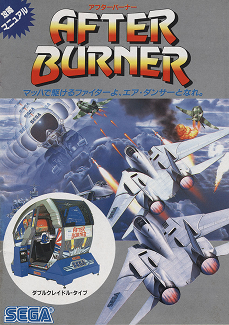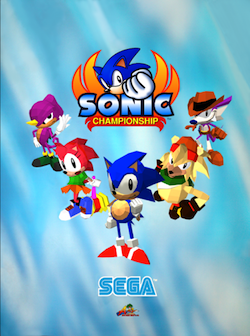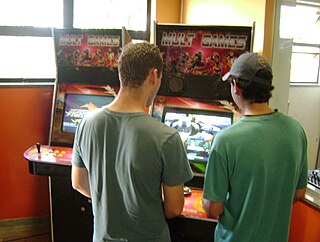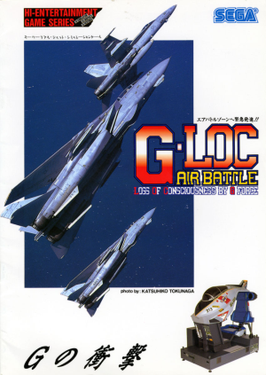Simulation video games are a diverse super-category of video games, generally designed to closely simulate real world activities. A simulation game attempts to copy various activities from real life in the form of a game for various purposes such as training, analysis, prediction, or entertainment. Usually there are no strictly defined goals in the game, and the player is allowed to control a character or environment freely. Well-known examples are war games, business games, and role play simulation. From three basic types of strategic, planning, and learning exercises: games, simulations, and case studies, a number of hybrids may be considered, including simulation games that are used as case studies. Comparisons of the merits of simulation games versus other teaching techniques have been carried out by many researchers and a number of comprehensive reviews have been published.

Yu Suzuki is a Japanese game designer, producer, programmer, and engineer, who headed Sega's AM2 team for 18 years. Considered one of the first auteurs of video games, he has been responsible for a number of Sega's arcade hits, including three-dimensional sprite-scaling games that used "taikan" motion simulator arcade cabinets, such as Hang-On, Space Harrier, Out Run and After Burner, and pioneering polygonal 3D games such as Virtua Racing and Virtua Fighter, which are some of the games besides others from rival companies during that era credited with popularizing 3D graphics in video games; as well as the critically acclaimed Shenmue series. As a hardware engineer, he led the development of various arcade system boards, including the Sega Space Harrier, Model 1, Model 2 and Model 3, and was involved in the technical development of the Dreamcast console and its corresponding NAOMI arcade hardware.

After Burner is a rail shooter arcade video game developed and released by Sega in 1987. The player controls an American F-14 Tomcat fighter jet and must clear each of the game's eighteen unique stages by destroying incoming enemies. The plane is equipped with a machine gun and a limited supply of heat-seeking missiles. The game uses a third-person perspective, as in Sega's earlier Space Harrier (1985) and Out Run (1986). It runs on the Sega X Board arcade system which is capable of surface and sprite rotation. It is the fourth Sega game to use a hydraulic "taikan" motion simulator arcade cabinet, one that is more elaborate than their earlier "taikan" simulator games. The cabinet simulates an aircraft cockpit, with flight stick controls, a chair with seatbelt, and hydraulic motion technology that moves, tilts, rolls and rotates the cockpit in sync with the on-screen action.

Sonic the Fighters, also known as Sonic Championship, is a 1996 three-dimensional fighting video game from Sega. The game, developed by Sega AM2 and built on their Model 2 arcade system, pits players in one-on-one battles with a roster of characters from the Sonic the Hedgehog series. Sonic the Fighters was made using the fighting engine for Fighting Vipers (1995), and it was the first 3D game in the Sonic series; the idea for a Sonic fighting game was conceived when a Sega AM2 programmer experimented with a 3D Sonic the Hedgehog model in Fighting Vipers, its animation impressing and convincing the Sonic Team to approve the project.

Daytona USA is a 1994 arcade racing game developed by Sega AM2. Inspired by the popularity of the NASCAR motor racing series in the US, the game has players race stock cars on one of three courses. It was the first game to be released on the Sega Model 2 arcade system board. Released by Sega in March 1994, Daytona USA is one of the highest-grossing arcade games of all time.

An arcade cabinet, also known as an arcade machine or a coin-op cabinet or coin-op machine, is the housing within which an arcade game's electronic hardware resides. Most cabinets designed since the mid-1980s conform to the Japanese Amusement Machine Manufacturers Association (JAMMA) wiring standard. Some include additional connectors for features not included in the standard.

Virtua Racing or V.R. for short, is a Formula One racing video game developed by Sega AM2 and released for arcades in 1992. Virtua Racing was initially a proof-of-concept application for exercising a new 3D graphics platform under development, the "Model 1". The results were so encouraging that Virtua Racing was fully developed into a standalone arcade title.

Sega AM Research & Development No. 2, previously known as SEGA-AM2 Co., Ltd., is a video game development team within the Japanese multinational video game developer Sega. Yu Suzuki, who had previously developed arcade games for Sega including Hang-On and Out Run, was the first manager of the department.

Hang-On is an arcade racing game released by Sega in 1985 and later ported to the Master System. In the game, the player controls a motorcycle against time and other computer-controlled bikes. It was one of the first arcade games to use 16-bit graphics and uses the Super Scaler arcade system board, created with design input from Yu Suzuki, as technology to simulate 3D effects. The deluxe cabinet version also introduced a motion-controlled arcade cabinet, where the player's body movement on a large motorbike-shaped cabinet corresponds with the player character's movements on screen.

Virtua Cop 2 is a light gun shooter arcade game, released in 1995 and developed internally at Sega by their AM2 studio. It was ported to the Sega Saturn in 1996, PC in 1997, and Sega Dreamcast in 2000. It was bundled with Virtua Cop in Virtua Cop: Elite Edition for PlayStation 2 in 2002.
Combat flight simulators are vehicle simulation games, amateur flight simulation computer programs used to simulate military aircraft and their operations. These are distinct from dedicated flight simulators used for professional pilot and military flight training which consist of realistic physical recreations of the actual aircraft cockpit, often with a full-motion platform.

G-LOC: Air Battle is a 1990 combat flight simulator arcade video game developed and published by Sega. It is a spin-off of the company's After Burner series. The title refers to "G-force induced Loss Of Consciousness". The game is known for its use of the R360 motion simulator arcade cabinet. The arcade game was a commercial and critical success upon release.

Virtua Fighter 3 is a 1996 fighting game developed and published by Sega, the sequel to 1994's Virtua Fighter 2 as part of the Virtua Fighter series. Released originally in arcades, Virtua Fighter 3 was the first arcade game to run on the Sega Model 3 system board. The use of this new hardware gave the game revolutionary graphics for its time. Two new characters were added to the roster: Aoi and Taka-Arashi, both of whom are oriented around traditional Japanese martial arts.

Rad Mobile is a racing arcade game developed by Sega AM3 and published by Sega. It was first published in Japan in October 1990, followed by an international release for arcades in February 1991. Rad Mobile was Sega's first 32-bit game, using Sega's System 32 arcade system board. It was also the first ever appearance of Sonic the Hedgehog, who appears as an ornament hanging from the driver's rearview mirror.
Virtua Fighter is a series of fighting games created by Sega AM2 and designer Yu Suzuki. The original Virtua Fighter was released in December 1993 and has received four main sequels and several spin-offs. The highly influential first Virtua Fighter game is widely recognized as the first 3D fighting game released. The latest mainline release was Virtua Fighter 5 in 2006; this version has since been continuously updated.

Joypolis is a chain of indoor amusement parks created by Sega and run by CA Sega Joypolis. Beginning on July 20, 1994 with the original location sited in Yokohama, Japan, Joypolis centers have since opened in several cities in Japan and later China. The parks feature arcade games and amusement rides based on Sega's intellectual properties, original themes, and licensed franchises. Alongside the predecessor Galbo venues and the overseas spin-offs SegaWorld London and Sega World Sydney, they were officially referred to under the "Amusement Theme Park" or "ATP" concept by Sega in the 1990s.
Electro-mechanical games are types of arcade games that operate on a combination of some electronic circuitry and mechanical actions from the player to move items contained within the game's cabinet. Some of these were early light gun games using light-sensitive sensors on targets to register hits, while others were simulation games such as driving games, combat flight simulators and sports games. EM games were popular in amusement arcades from the late 1940s up until the 1970s, serving as alternatives to pinball machines, which had been stigmatized as games of chance during that period. EM games lost popularity in the 1970s, as arcade video games had emerged to replace them in addition to newer pinball machines designed as games of skill.

Transformers: Human Alliance is a rail shooter arcade game developed by Sega, Set within the Transformers film franchise, it is the first arcade video game in the Transformers franchise. It was showcased in November 2013 at the IAAPA Attractions Show in Orlando; a local Dave & Busters location publicly launched the game at this time. The name is based on the toyline by Hasbro and Takara Tomy, which were mostly the Transformers characters which came with the humans from the films, and lasted from 2009–2011.
VR-1 is a virtual reality amusement park attraction released by Sega. Installed publicly for the first time in July 1994 at the opening of the original Joypolis indoor theme park, Yokohama Joypolis, it represented the culmination of Sega's Japanese AM teams and the Virtuality Group's collaborative developments in the field of VR. In 1996 and 1997, respectively, it was also installed at SegaWorld London and Sega World Sydney.

An arcade game or coin-op game is a coin-operated entertainment machine typically installed in public businesses such as restaurants, bars and amusement arcades. Most arcade games are presented as primarily games of skill and include arcade video games, pinball machines, electro-mechanical games, redemption games or merchandisers.
















